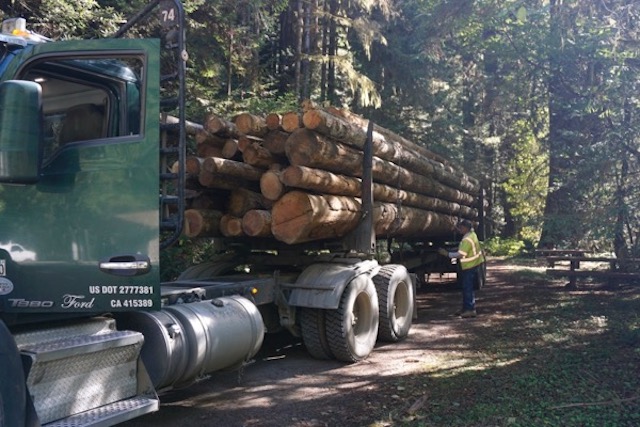The latest in logging pretexts
It takes a special kind of Orwellian cynicism to name a logging project – including logging young redwood trees – “Redwoods Rising“. Our story:
 As I hiked in old growth redwood forests in Redwood National Park along Lost Man Creek trail -an old logging road, ironically the site of the 1982 ceremony designating the forest as a “World Heritage Site”- despite the “road closed” sign at the trailhead, I was assaulted by logging trucks hauling substantial 10 – 25 inch diameter trees, which were mostly Douglas fir, but included redwoods.
As I hiked in old growth redwood forests in Redwood National Park along Lost Man Creek trail -an old logging road, ironically the site of the 1982 ceremony designating the forest as a “World Heritage Site”- despite the “road closed” sign at the trailhead, I was assaulted by logging trucks hauling substantial 10 – 25 inch diameter trees, which were mostly Douglas fir, but included redwoods.
So, I stopped by the nearby National park public information center to ask about what was going on.
After getting nervous runarounds from a young park desk employee – who played dumb – I was referred to the supervisor.
She too initially gave me a runaround, telling me that the trail was closed. When I replied that I saw several logging trucks on it, she again dodged, by asking if I had specific information, like the name of the logging company trucks.
When I replied that the trucks were operated by “Pacific Earthscape” (hit the link and look at the photo of logging/roadbuilding on steep slopes and note the corporate logo” Pacific Earthscape Builds Smarter“), she suddenly understood what I was referring to and said: “Oh, they work for us”.
She explained the project, and was careful to respond to my question that all logging revenues were dedicated in a special account for managing the project. Still, the conflict between science and securing agency funding remains, a conflict made worse in a time of scarce resources and budget cuts.
We’ve seen all sorts of “justifications” for logging – including creating of “young forest” or early successional habitat for endangered migratory birds; salvage logging of forests disturbed by insects and fire; logging to accelerate carbon sequestration; and logging to reduce “fuels” and prevent wildfires – but the “Redwoods Rising” “restoration” pretext was new to us.
According to the National Park Service (bold mine)
This restoration effort will involve forest and vegetation management, legacy logging road removal and road maintenance, cultural site protection, watershed management, as well as reducing the amounts of erosion and sediment going into rivers and streams.
I don’t have time to adequately research this project, but I scanned the NPS website but could not find links to the scientific support documents and the NEPA Environmental Impact Statement. I don’t know the organizational lay of the land out here, but did find supporting NEPA scoping comments from a group called “EPIC”
“Redwoods Rising” may in fact be a wonderful project to restore old growth redwood forests, as the NGO champions claim, with all these PR slogans (my emphasis):
Redwoods Rising will bring the collaborative, landscape-scale visioning, planning, and project implementation necessary to increase the pace of redwood forest restoration. It will provide additional support to improve stream health, restore critical wildlife habitat, and remove invasive species. It will allow us to reconnect remaining old-growth stands, set previously logged areas back on a trajectory towards old-growth conditions, and create landscapes that will be resilient in the face of future climate change.
But I doubt it.
Here’s what the proponents view as the problem:
Despite their ecological wealth, and stunning beauty, these forests are far from being places of pristine, untouched wilderness. Large swaths of the parks were scarred by decades of logging, which left behind eroding roads, impaired streams, and spindly, young trees that hold neither the magic of an ancient forest nor its ecological strengths.
Do these 50 – 75 year old Douglas firs look like “spindly, young trees“?
Does the carbon sequestered in those trees move us towards resilient climate change?
Will ecosystems benefit when nursing trees and stored nutrients are removed from the forest via logging?
Will threats from invasive species be reduced when more sunlight hits the forest floor as a result of logging?
Do these going trucks look like they are restoring “eroding roads” and improving water quality?
Will the project really “increase the pace of redwood forest restoration”?
How will young redwoods and ferns thrive in the bright sunlight of a greatly reduced canopy in a logged forest?
Even if they will, restoration of old growth characteristics will take hundreds of years. What’s the hurry?
Why not let nature “thin” the forest and allow old growth forests to emerge naturally?
Haven’t the forest mangers learned anything about the arrogance of human management?





Pingback: WolfeNotes.com » From Happy Camp, Heart of the Klamath To San Francisco (Before the Digital Disaster)